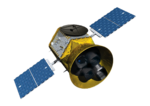Astronomy:Explorer 36
| Mission type | Earth science |
|---|---|
| Operator | NASA |
| COSPAR ID | 1968-002A[1] |
| SATCAT no. | 3093 |
| Spacecraft properties | |
| Manufacturer | Applied Physics Laboratory[2] |
| Launch mass | 469 kg (1,034 lb) |
| Start of mission | |
| Launch date | January 11, 1968, 16:16:10 UTC[3][4] |
| Rocket | Delta-E1 454/D56 |
| Launch site | Vandenberg Air Force Base SLC-2E |
| Orbital parameters | |
| Reference system | Geocentric |
| Regime | Low Earth |
| Eccentricity | 0.03615[1] |
| Perigee altitude | 1,082 kilometers (672 mi)[1] |
| Apogee altitude | 1,570 kilometers (980 mi)[1] |
| Inclination | 105.8°[1] |
| Period | 112.2 minutes[1] |
| Epoch | 11 January 1968[1] |
Explorers | |
Explorer 36 (also called GEOS 2 or GEOS B, acronym to Geodetic Earth Orbiting Satellite) was a U.S. satellite launched as part of the Explorers program, being the second of the two satellites GEOS. Explorer 36 was launched on January 11, 1968 from Vandenberg Air Force Base , with Delta rocket.
Explorer 36 was a gravity-gradient-stabilized, solar cell powered spacecraft that carried electronic and geodetic instrumentation. The geodetic instrumentation systems included:
- Optical Beacon System
- Radio Doppler System
- SECOR Range Transponder
- Radio Range/Rate System
- C-Band Radar Transponder
- NASA Minitrack System
- Precipitating Electron Detector
- Magnetometer
- Laser Tracking Reflector
Non-geodetic systems included a laser detector and a Minitrack interferometer beacon. The objectives of the spacecraft were to optimize optical station visibility periods and to provide complementary data for inclination-dependent terms established by the Explorer 29 (GEOS 1) gravimetric studies. The spacecraft was placed into a retrograde orbit to accomplish these objectives. Operational problems occurred in the main power system, optical beacon flash system, and the spacecraft clock, and adjustments in scheduling resulted in nominal operations.[1]
See also
References
- ↑ 1.0 1.1 1.2 1.3 1.4 1.5 1.6 1.7 "GEOS". NSSDCA. NASA Goddard Space Flight Center. https://nssdc.gsfc.nasa.gov/nmc/spacecraft/display.action?id=1968-002A. Retrieved 17 June 2018.
 This article incorporates text from this source, which is in the public domain.
This article incorporates text from this source, which is in the public domain.
- ↑ "GEOS". Encyclopedia Astronautica. Mark Wade. http://www.astronautix.com/g/geos.html. Retrieved 17 June 2018.
- ↑ McDowell, Jonathan. "Launch Log". Jonathan's Space Page. http://planet4589.org/space/log/launchlog.txt. Retrieved 17 June 2018.
- ↑ Antonín Vítek, Lubor Lejček (17 January 2012). "1968-002A - Explorer 36" (in Czech). Space 40. https://www.lib.cas.cz/space.40/1968/002A.HTM. Retrieved 17 June 2018.
External links


